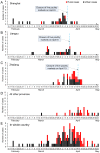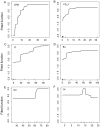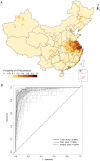Mapping spread and risk of avian influenza A (H7N9) in China
- PMID: 24072008
- PMCID: PMC3784030
- DOI: 10.1038/srep02722
Mapping spread and risk of avian influenza A (H7N9) in China
Abstract
The outbreak of human infections with an emerging avian influenza A (H7N9) virus occurred in China in early 2013. It remains unknown what and how the underlying risk factors were involved in the bird-to-human cross-species transmission. To illustrate the dynamics of viral spread, we created a thematic map displaying the distribution of affected counties and plotted epidemic curves for the three most affected provinces and the whole country. We then collected data of agro-ecological, environmental and meteorological factors at the county level, and used boosted regression tree (BRT) models to examine the relative contribution of each factor and map the probability of occurrence of human H7N9 infection. We found that live poultry markets, human population density, irrigated croplands, built-up land, relative humidity and temperature significantly contributed to the occurrence of human infection with H7N9 virus. The discriminatory ability of the model was up to 97.4%. A map showing the areas with high risk for human H7N9 infection was created based on the model. These findings could be used to inform targeted surveillance and control efforts in both human and animal populations to reduce the risk of future human infections.
Figures




Similar articles
-
Risk Distribution of Human Infections with Avian Influenza H7N9 and H5N1 virus in China.Sci Rep. 2015 Dec 22;5:18610. doi: 10.1038/srep18610. Sci Rep. 2015. PMID: 26691585 Free PMC article.
-
The role of live poultry movement and live bird market biosecurity in the epidemiology of influenza A (H7N9): A cross-sectional observational study in four eastern China provinces.J Infect. 2015 Oct;71(4):470-9. doi: 10.1016/j.jinf.2015.06.012. Epub 2015 Jul 3. J Infect. 2015. PMID: 26149187
-
Surveillance for avian influenza A(H7N9), Beijing, China, 2013.Emerg Infect Dis. 2013 Dec;19(12):2041-3. doi: 10.3201/eid1912.130983. Emerg Infect Dis. 2013. PMID: 24274700 Free PMC article.
-
[The effects of closure to live poultry markets on Avian influenza A (H7N9) epidemics in China].Zhonghua Liu Xing Bing Xue Za Zhi. 2017 Dec 10;38(12):1716-1718. doi: 10.3760/cma.j.issn.0254-6450.2017.12.027. Zhonghua Liu Xing Bing Xue Za Zhi. 2017. PMID: 29294594 Review. Chinese.
-
Viral lung infections: epidemiology, virology, clinical features, and management of avian influenza A(H7N9).Curr Opin Pulm Med. 2014 May;20(3):225-32. doi: 10.1097/MCP.0000000000000047. Curr Opin Pulm Med. 2014. PMID: 24637225 Review.
Cited by
-
Ecological Niche Modeling of Risk Factors for H7N9 Human Infection in China.Int J Environ Res Public Health. 2016 Jun 16;13(6):600. doi: 10.3390/ijerph13060600. Int J Environ Res Public Health. 2016. PMID: 27322296 Free PMC article.
-
Risk distribution of human infections with avian influenza A (H5N1, H5N6, H9N2 and H7N9) viruses in China.Front Public Health. 2024 Oct 24;12:1448974. doi: 10.3389/fpubh.2024.1448974. eCollection 2024. Front Public Health. 2024. PMID: 39512713 Free PMC article.
-
Could Environment Affect the Mutation of H1N1 Influenza Virus?Int J Environ Res Public Health. 2020 Apr 29;17(9):3092. doi: 10.3390/ijerph17093092. Int J Environ Res Public Health. 2020. PMID: 32365515 Free PMC article.
-
Low-Cost Battery-Powered and User-Friendly Real-Time Quantitative PCR System for the Detection of Multigene.Micromachines (Basel). 2020 Apr 21;11(4):435. doi: 10.3390/mi11040435. Micromachines (Basel). 2020. PMID: 32326194 Free PMC article.
-
Influenza A H5N1 and H7N9 in China: A spatial risk analysis.PLoS One. 2017 Apr 4;12(4):e0174980. doi: 10.1371/journal.pone.0174980. eCollection 2017. PLoS One. 2017. PMID: 28376125 Free PMC article.
References
-
- Gao R. B. et al. Human infection with a novel avian-origin influenza A (H7N9) virus. N Engl J Med. 368, 1888–1897(2013). - PubMed
-
- Horby P. H7N9 is a virus worth worrying about. Nature. 496, 399 (2013). - PubMed
-
- National Health and Family Planning Commission of the People's Republic of China. Effect of prevention and control of human infection with avian influenza A(H7N9) virus in China. (http://www.moh.gov.cn/mohwsyjbgs/s3578/201306/10abe6296ba347a89f8153869c... (Accessed 2 July 2013).
-
- Li Q. et al. Preliminary report: epidemiology of the avian influenza A (H7N9) outbreak in China. N Engl J Med. 10.1056/NEJMoa1304617 (Accessed 2 July 2013).
Publication types
MeSH terms
Grants and funding
LinkOut - more resources
Full Text Sources
Other Literature Sources
Medical

